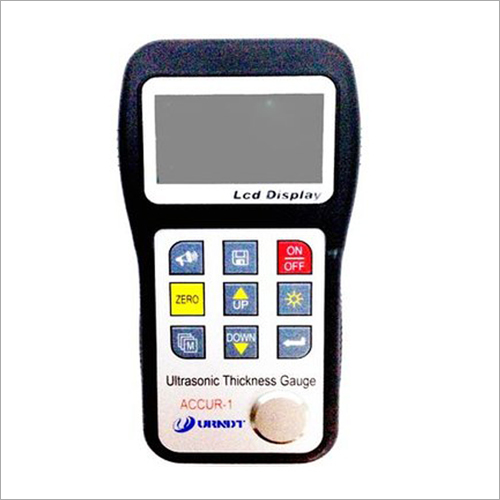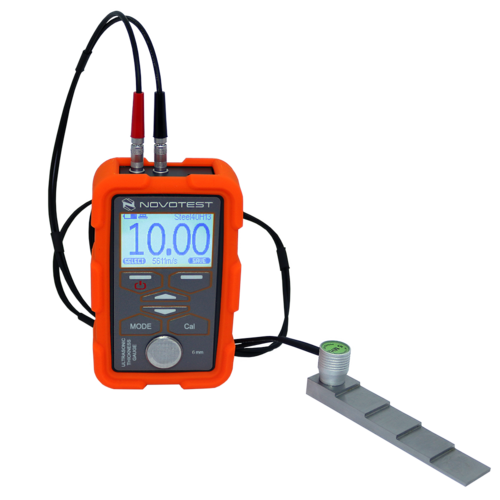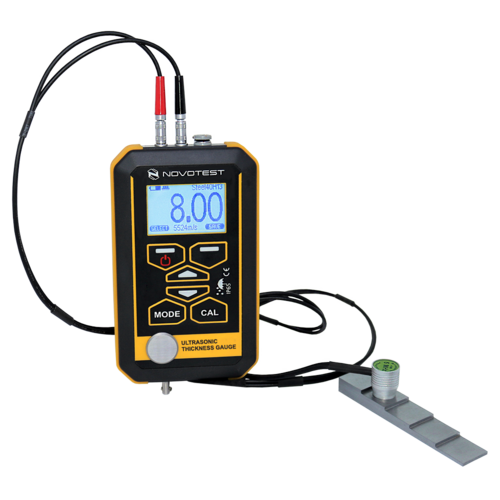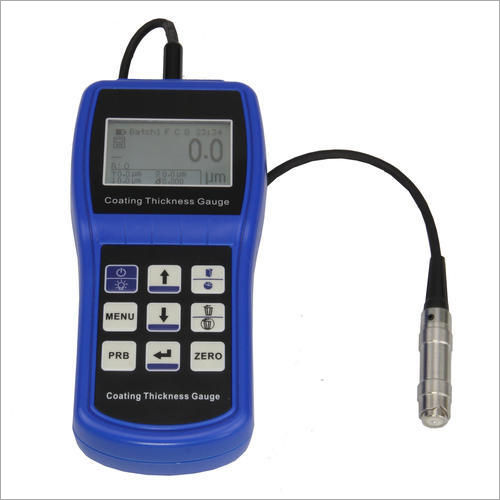Ultrasonic Thickness Gauge
20000.00 INR/Piece
Product Details:
- Frequency 50-60 Hertz (HZ)
- Usage Industrial
- Size 150mm X 74mm X32mm
- Material Stainless Steel
- Product Type Ultrasonic Thickness Gauge
- Color Black
- Accuracy 0.5 %
- Click to View more
X
Ultrasonic Thickness Gauge Price And Quantity
- 20000.00 INR/Piece
- 1 , , Piece
Ultrasonic Thickness Gauge Product Specifications
- Ultrasonic Thickness Gauge
- Stainless Steel
- Black
- 0.5 %
- 150mm X 74mm X32mm
- Industrial
- 50-60 Hertz (HZ)
Ultrasonic Thickness Gauge Trade Information
- 100 , , Piece Per Week
- 7-10 Days
Product Description
An ultrasonic thickness gauge is a device used to measure the thickness of a material using ultrasonic waves. Its commonly employed in various industries such as manufacturing, construction, aerospace, and marine to assess the integrity of materials like metal, plastic, glass, and composites.
Heres how it typically works:
1. Transducer: The ultrasonic thickness gauge consists of a handheld device with a probe or transducer. The transducer emits ultrasonic waves (sound waves with frequencies above the range of human hearing) into the material being measured.
2. Propagation of Waves: These ultrasonic waves travel through the material until they encounter the opposite surface. Upon reaching the surface, they reflect back to the transducer.
3. Measurement: By measuring the time it takes for the ultrasonic waves to travel from the transducer to the materials surface and back, the device calculates the thickness of the material. The speed of sound in the material is a critical parameter used in this calculation.
4. Display: The thickness measurement is displayed on the gauges screen. Some advanced models may also provide additional features such as data logging, statistical analysis, and connectivity options.
5. Calibration: Ultrasonic thickness gauges need to be calibrated for accuracy, typically against known standards or reference materials.
Ultrasonic Thickness Gauge Specifications:
1. Model Name/Number: PRO ACCUR-1
2. Measuring Range: 0.75mm to 500.0mm
3. Size: 150mm X 74mm X32mm
4. Materials: Steel
5. Accuracy: 0.5 %
6. Battery Type: Type AA alkaline battery 1.5 V 2
7. Operating Temperature: -10 to 60 Deg
Ultrasonic Thickness Gauge Applications:
1. Manufacturing: Ultrasonic thickness gauges are used during the manufacturing process to ensure the thickness of materials meets design specifications. This includes materials such as metal sheets, pipes, tanks, and other fabricated components.
2. Corrosion Inspection: One of the primary uses of ultrasonic thickness gauges is in assessing corrosion levels in structures made of metals like steel or aluminum. By measuring the remaining thickness of the material, inspectors can determine the extent of corrosion and assess the structural integrity.
3. Petrochemical Industry: In industries dealing with pipelines, storage tanks, and pressure vessels such as oil and gas, petrochemicals, or chemical processing plants, ultrasonic thickness gauges are vital for monitoring corrosion and detecting potential weaknesses that could lead to leaks or failures.
4. Aerospace and Aviation: Ultrasonic thickness gauges are used for inspecting aircraft components such as fuselage, wings, and engine parts to ensure they meet safety standards and have not experienced significant thinning due to fatigue, corrosion, or other factors.
5. Marine Industry: In ships, boats, and offshore structures, ultrasonic thickness gauges are employed for monitoring hull thickness to prevent hull corrosion, assess structural integrity, and determine the need for maintenance or repair.
6. Construction: Ultrasonic thickness gauges are used in construction for assessing the thickness of concrete structures, such as bridges, tunnels, and buildings, to ensure they meet design specifications and maintain structural integrity over time.
7. Automotive Industry: In automotive manufacturing and maintenance, ultrasonic thickness gauges are used to measure the thickness of automotive components like body panels, chassis, and engine parts, helping ensure quality and safety standards are met.
8. Power Generation: In power plants, ultrasonic thickness gauges are utilized for inspecting boiler tubes, piping, and other components to monitor for corrosion, erosion, and other forms of degradation that could compromise safety and efficiency.
Ultrasonic Thickness Gauge FAQ:
Q. How does an ultrasonic thickness gauge work?
Ans: Ultrasonic thickness gauges work by emitting ultrasonic waves from a transducer into the material being measured. These waves travel through the material and reflect back to the transducer. By measuring the time it takes for the waves to travel and return, the gauge calculates the thickness of the material.
Q. What materials can be measured with an ultrasonic thickness gauge?
Ans: Ultrasonic thickness gauges can measure the thickness of a wide range of materials, including metals (steel, aluminum, copper, etc.), plastics, glass, composites, and more.
Q. What are the advantages of using an ultrasonic thickness gauge?
Ans: Advantages of ultrasonic thickness gauges include non-destructive testing, fast and accurate measurements, suitability for a wide range of materials and applications, and the ability to inspect structures without disassembly.
Q. What factors can affect the accuracy of measurements?
Ans: Factors such as material properties, surface conditions (roughness, curvature), temperature, and the presence of coatings or layers can affect the accuracy of ultrasonic thickness measurements. Proper calibration and technique are important for obtaining accurate results.
Q. How do I calibrate an ultrasonic thickness gauge?
Ans: Ultrasonic thickness gauges need to be calibrated for accuracy, typically against known standards or reference materials. Calibration procedures may vary depending on the specific model and manufacturer instructions.
Q. Can ultrasonic thickness gauges measure through coatings or paint?
Ans: Yes, ultrasonic thickness gauges can often measure through thin coatings or paint layers to determine the thickness of the underlying material. However, the accuracy of measurements may be affected by the properties of the coating.
Q. Are ultrasonic thickness gauges portable?
Ans: Yes, most ultrasonic thickness gauges are designed to be portable and handheld for ease of use in various industrial settings.
Q. What are some common applications of ultrasonic thickness gauges?
Ans: Common applications include manufacturing, corrosion inspection, petrochemical industry, aerospace, marine industry, construction, automotive industry, power generation, and more.
Q. Are there different types of ultrasonic thickness gauges?
Ans: Yes, there are different types of ultrasonic thickness gauges available, including basic handheld models, advanced models with additional features such as data logging and connectivity options, and specialized gauges for specific applications or industries.
High-Precision Industrial Measuring
The Ultrasonic Thickness Gauge delivers reliable thickness measurements with an accuracy of 0.5%. Whether used in manufacturing or facility maintenance, its advanced technology ensures repeatable readings on a variety of materials. The stainless steel construction and compact design make it an essential tool for professionals concerned with safety and efficient workflow.
Versatile Application and Robust Design
Engineered for industrial use, this gauge is compatible with various industrial surfaces and works efficiently at 50-60 Hz. The sturdy black exterior and ergonomic size make it convenient to carry and operate in diverse environments, both indoors and outdoors, ensuring consistent and accurate results every time.
FAQs of Ultrasonic Thickness Gauge:
Q: How does the Ultrasonic Thickness Gauge operate?
A: The Ultrasonic Thickness Gauge functions by emitting ultrasonic pulses through the material with its probe, then measures the time taken for the echo to return. This process allows it to calculate the materials thickness with high accuracy, even without direct access to both sides of the object.Q: What materials can this gauge measure accurately?
A: The gauge is made from stainless steel and is capable of accurately measuring the thickness of a wide range of industrial materials, including metals, plastics, and composites, making it suitable for diverse sectors.Q: When is the ideal time to use an Ultrasonic Thickness Gauge?
A: The gauge is best used during routine maintenance, inspection, or quality control processes whenever precise thickness measurements are needed to ensure equipment safety and compliance with industry standards.Q: Where can this thickness gauge be utilized?
A: This device can be used in various industrial settings such as manufacturing facilities, service workshops, and inspection sites across India. It is suitable for both indoor and outdoor applications due to its robust build.Q: What is the process of measuring thickness with this instrument?
A: To use the gauge, simply apply the probe to the clean surface of the material, ensuring proper contact. Activate the device and read the measurement displayed on the screenthis entire process takes just a few seconds.Q: How does using this thickness gauge benefit businesses?
A: By providing accurate and non-destructive thickness measurements, this gauge helps businesses maintain quality control, prevent structural failures, and extend the lifespan of industrial equipment, all while streamlining maintenance and safety assessments.Tell us about your requirement

Price:
Quantity
Select Unit
- 50
- 100
- 200
- 250
- 500
- 1000+
Additional detail
Mobile number
Email
 English
English Spanish
Spanish French
French German
German Italian
Italian Chinese (Simplified)
Chinese (Simplified) Japanese
Japanese Korean
Korean Arabic
Arabic Portuguese
Portuguese







